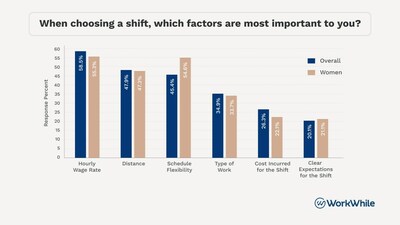We might think of flexible workers as the fiercely independent type—maybe young or single with few responsibilities. We think of them as those who might say that they love flex work because, “You are your own boss. Work the hours you want to work.” And many flex workers think that way! However, flexibility can also be the foundation of stability for populations who need it most—like women with children. In our research, we have found that flex work attracts large swaths of people who want the ability to fit work into their lives—not the other way around.
Meet the flexible workers who are here to stay.
Experienced Workers Win
Of those who responded to the survey, workers report that on average 51% of their income comes from flex work. That number jumps up to 57% for those with at least 3 years of experience with flex work. In total, 63% of experienced workers make at least half of their income from flex work.
Flexible workers are not immune to the worries of the challenging economy over recent years—but those with more experience report more confidence than their counterparts. 49% of all workers report that they are “Always” worried about their finances, while less than 3% say they are “Never” worried. However, the number of those that “Never” worry about their finances triples as a worker has more experience with flexible work. Of those who have been doing flexible work for over 8 years, 10% report that they are never worried about their finances. Counterintuitive as it may seem, the longer someone has done flexible work, the more stable and confident they feel in their financial life.
Why Workers Choose Flexible Work
Despite its reputation, flex work is not a side hustle where workers lack reliability or tenure. Our survey found that 63% of respondents have had more than 1 year of experience in flexible work, while a whopping 29% have 3 years or more experience. There are very few other hourly jobs that can boast retention rates that high. When asked to rank their preference between flexible jobs and a traditional 9-5, only 8% said they prefer traditional work over flexible, and the reasons are not all that surprising.
When asked what factors are most important in choosing a shift, respondents report their top 4 factors as: Hourly Wage Rate, Distance, Schedule Flexibility, and Type of Work. Compared to all workers, women with children put a higher premium on schedule flexibility by nearly 13%—ranking their top priorities as Schedule Flexibility, Hourly Wage Rate, and Distance to Shift. Like with any job, flexible workers care about making good wages, having a schedule that fits their lives, and convenience.
Notably, flexible workers tend to be satisfied with their wages too. 73% of respondents said that flexible work pays at least as much or more than traditional jobs. If two jobs pay the same, while one offers complete schedule control, it makes a lot of sense why hourly wage workers are turning to flex work to pay their bills.
Women with Children Make Flexible Work Work for Them
As we dove into the data, we immediately noticed that women with children started to pull away in many categories including satisfaction with flexible work. Right off the bat, only 5.6% of women with children said they preferred traditional work over flexible work, while 8.5% of the remainder of those surveyed said the same. Turns out that moms doing a lot of flexible work often get more time with their families. Women with children who make more than 75% of their income doing flexible work spend on average 6 more hours per week with their families than women with children making between 25-50% of their income from flexible work.
In the open-ended responses, one mom, who chose to stay anonymous, said the reason she prefers flexible work is that “as a single parent, choosing my own schedule is great. As things come up, I don’t always have the help I need to care for my child.” The hours work for them, and it seems that the pay works for them too. 74% of women with children say that flexible work pays equal to or better than traditional jobs
Flexible Work is Already Here
What does all this say about the future of flexible work and the people who do it? It signals a very clear difference between what we think of flexible workers versus who they really are. We see patterns of stability, confidence, and reliability in a workforce so often characterized in very narrow terms. Notably, flexible work disproportionately supports mothers and is increasingly becoming a reliable source of income for all workers. More and more everyday people are leveraging the power of flexible work to cover their bills, make time for their families, and control their own lives. It’s not just the future of work, it’s the present.
“[Flex Work] gives me the freedom to be there for my son and also pursue things I’m passionate about.” —WorkWhile Worker, 2023
About WorkWhile
WorkWhile is an hourly labor marketplace that optimizes flexibility and control for our business partners and stability for our workers. We use behavioral analysis, peer feedback, and powerful machine learning models to help identify the most reliable hourly workers and support them with perks not often available at traditional hourly wage jobs. Businesses get access to a quality workforce, while workers earn stable incomes and unmatched perks & benefits.
WorkWhile is available in Arizona, California, Colorado, Florida, Georgia, Illinois, Maryland, New Jersey, Nevada, New York, Pennsylvania, South Carolina, Tennessee, Texas, Virginia, Washington, and Washington, D.C.


